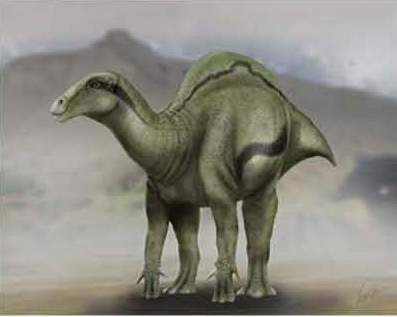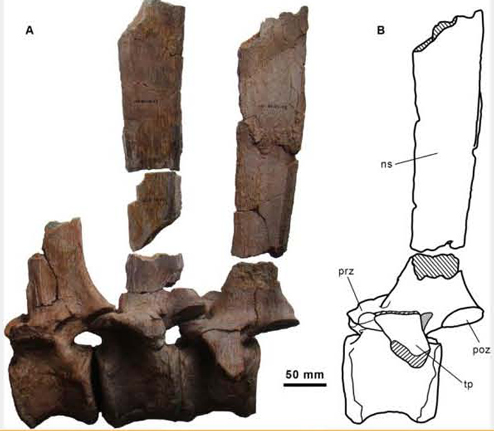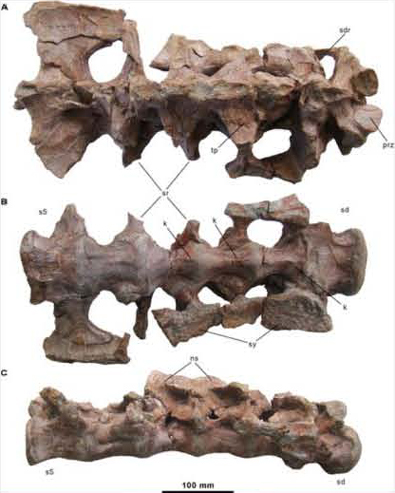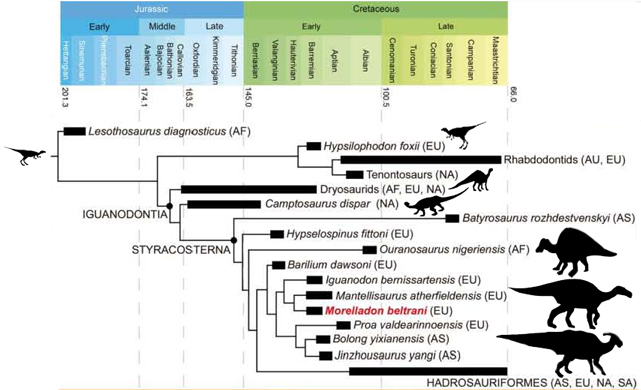New Sail-Backed Dinosaur from Early Cretaceous Spain
Morelladon beltrani – A Spanish Sail-Backed Dinosaur
A team of Spanish scientists have published details of a new genus of plant-eating dinosaur which roamed the Iberian Peninsula about 125 million years ago (Early Cretaceous). The dinosaur named Morelladon beltrani is believed to have been closely related to Iguanodon and the discovery helps to reinforce the belief held by many palaeontologists that the Ornithopoda were extremely diverse in Europe during this part of the Cretaceous.
Sail-backed Dinosaur
The dorsal vertebrae have large, extended neural spines a feature seen in other Early Cretaceous ornithopods, dinosaurs such as Ouranosaurus from Niger. These spines may have supported a hump or perhaps a sail-like structure, the purpose of which remains open to debate.
An Illustration of Morelladon beltrani
Picture credit: Universidad Nacional de Educación a Distancia (Spain)
This new species of dinosaur has been named from the fossilised remains of a single animal, preserved bones consist of dorsal vertebrae, the sacrum, partial ribs, the pelvic girdle, isolated teeth from the lower jaw and the right tibia.
However, despite a lack of cranial material, the team of scientists from the Spanish equivalent of the Open University (Universidad Nacional de Educación a Distancia) and the Autonomous University of Madrid (Universidad Autónoma de Madrid), identified eight unique anatomical features (autapomorphic features) that enabled a new genus to be established.
Elongated Neural Spines
One of the unique anatomical features identified were the very elongated and tall neural spines of the dorsal vertebrae. Such features are known in other plant-eating dinosaurs, such as the Ouranosaurus (Ouranosaurus nigeriensis) from the Early Cretaceous of Africa and although Morelladon is related to Ouranosaurus, a phylogenetic analysis carried out by the Spanish team suggests that this new Spanish dinosaur is more closely related to other western European dinosaur taxa. Dinosaurs such as Iguanodon (I. bernissartensis) from Belgium and Mantellisaurus atherfieldensis (from England).
The Extended Neural Spines of the Dorsal Vertebrae
Picture credit: Universidad Nacional de Educación a Distancia (Spain)/PLOS One
Close to the City of Morella
The fossils come from a dig site within a quarry about five miles south-west of the city of Morella (Castellón Province), on the eastern coast of Spain. The specimen was excavated from a red clay bed dated to the Upper Barremian age (125 million years ago), part of the Arcillas de Morella Formation. The dinosaur’s name means “Morella tooth”, after the location of the fossil find and in keeping with the naming of Iguanodon, which itself means “iguana tooth”. The trivial name honours quarry owner, Víctor Beltrán who has been prominent in the excavation and research of a number of Cretaceous vertebrates from this part of Spain.
The Fused Sacral Vertebrae of the Specimen (Sacrum)
Picture credit: Universidad Nacional de Educación a Distancia (Spain)/PLOS One
Measuring up to six metres long and standing around 2.5 metres high at the hips, this new genus supports the hypothesis that the Iberian Peninsula in the Early Cretaceous was home to a large number of different types of Iguanodon-like herbivorous dinosaurs.
Why the Tall Neural Spines?
There have been a number of theories put forward to explain the presence of elongated neural spines in some types of dinosaur. For example, one of the most famous of all the meat-eating dinosaurs – Spinosaurus had neural spines which supported a structure its back, often referred to as a “sail” that must have been more than two metres high. The neural spines of Morelladon hint at a much smaller feature, around half a metre tall.
It has been proposed that since this dinosaur lived in a delta subject to distinct seasons the spines could have supported a fleshy hump where food reserves and fat could be stored to help the animal through leaner times. Extant North American buffalo (Bison bison) have dorsal spines that support such structures. The spines could also have supported a sail-like structure, perhaps this had a role in communication within the herd, or display.
Commenting on another potential purpose for the structure, Dr Fernando Escaso (Universidad Nacional de Educación a Distancia) stated:
“The “sail” could have helped in heat exchange [thermoregulation] by releasing excess body heat into the environment as do the ears of the modern-day elephants.”
An effective heat exchanger would have been useful for such a large-bodied animal. Everything Dinosaur team members suspect that oxygen isotope analysis from the many different types of teeth found in eastern Spain in Early Cretaceous rocks, would provide palaeontologists with a lot of information about the palaeoclimate. For instance, some researchers claim that there was an annual average temperature range of thirty-six degrees with temperatures in excess of 40 degrees Celsius being recorded with annual lows of around 4 degrees C.
What are Styracosternan Dinosaurs?
Other media sources have cited the comment that Morelladon represents a new member of the styracosternan sub-group of the clade Iguanodontia. What does this mean? In the mid 1980s it had become clear to many palaeontologists that the division of the Ornithopoda into large bodied forms such as Iguanodon and Dollodon and smaller forms such as Hypsilophodon was over simplistic.
A number of academics proposed new classifications of these bird-hipped dinosaurs, for example Paul Sereno (1986) proposed a new clade within the Ornithopoda called the Ankylopollexia “stiff thumbs”. This clade included the camptosaurs, iguanodonts, Ouranosaurus and the hadrosaurids “duck-billed dinosaurs”. This clade was further divided by Sereno et al (1986) into the Styracosterna, which included all the Ankylopollexia members with the exception of the camptosaurids (Camptosauridae family).
- Ankylopollexia = a clade of the iguanodontian dinosaurs
- Styracosterna = a clade of the iguanodontian dinosaurs the same as Ankylopollexia but with the camptosaurids excluded.
Therefore, the Styracosterna dinosaurs can be divided as a sub-group of the Iguanodontia clade that contains all the “duck-billed dinosaurs” and all the dinosaurs more closely related to them than to the Camptosauridae.
Phylogenetic relationships of Morelladon beltrani within the Iguanodontia Clade
Picture credit: PLOS One with additional annotation by Everything Dinosaur
The diagram above shows how the Styracosterna fit into the clade Iguanodontia. Phylogenetic analysis places Morelladon beltrani firmly in the with the styracosternan dinosaurs but more closely related to Western European iguanodonts such as Iguanodon bernissartensis and Mantellisaurus atherfieldensis than to other Iberian styracosternans such as Delapparentia turolensis and Proa valdearinnoensis.
For models and replicas of ornithopods and other prehistoric animals: CollectA Age of Dinosaurs.





